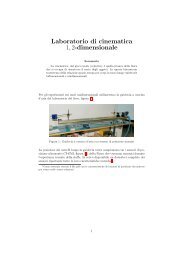Newton's law of cooling revisited - Cartan
Newton's law of cooling revisited - Cartan
Newton's law of cooling revisited - Cartan
Create successful ePaper yourself
Turn your PDF publications into a flip-book with our unique Google optimized e-Paper software.
Newton’s <strong>law</strong> <strong>of</strong> <strong>cooling</strong> <strong>revisited</strong> 1067<br />
a linear equation. This makes sense, if temperature differences are small (Tobj ≈ Tsurr, i.e.<br />
�T ≪ Tsurr, Tobj), since in this case<br />
� 4<br />
Tobj − T 4 �<br />
surr = kappr(T ) · (Tobj − Tsurr), (4)<br />
where kappr (T) ≈ 4T 3 Surr .UsingαRad = ε · σ · kappr, equation (3) can be rewritten as<br />
˙QRad = αRad · A · (Tobj − Tsurr), (5)<br />
which is <strong>of</strong> the same type as the heat-transfer equations for conduction and convection.<br />
3. Conduction within solids: the Biot number<br />
In the experiments described below, information about the temperatures <strong>of</strong> solid objects will<br />
be gained from the surface temperatures <strong>of</strong> these objects. It is important to know how these<br />
surface temperatures are related to average temperatures in order to correctly model the <strong>cooling</strong><br />
process.<br />
Consider a solid, which is between two fluids <strong>of</strong> different but constant temperatures T1<br />
and T2. Assuming steady state conditions the heat flows due to conduction, convection and<br />
radiation will lead to a spatial temperature distribution within the object. It is possible to get<br />
some idea on this temperature distribution within the solid by using the so-called Biot number<br />
Bi.<br />
Bi = αConv<br />
αCond<br />
= αConv<br />
. (6)<br />
λ/s<br />
The Biot number is a dimensionless quantity, usually describing the ratio <strong>of</strong> two adjacent<br />
heat-transfer rates. In the present case, it describes the ratio <strong>of</strong> the outer heat flow from the<br />
surface to the surrounding, characterized by the convective heat-transfer coefficient αConv at the<br />
surface, and the inner heat flow within the object characterized by the conductive heat-transfer<br />
coefficient αcond = (λ/s). For Bi ≫ 1, the outer heat flow is much larger than the inner heat<br />
flow. Obviously, this will result in a strong spatial variation <strong>of</strong> internal temperature within the<br />
object. This is typical for walls <strong>of</strong> buildings. If however, Bi ≪ 1, the internal heat flow is much<br />
larger than the heat loss from the surface. Therefore, there will be temperature equilibrium<br />
within the object, i.e. a homogeneous temperature distribution within the solid and the drop at<br />
the boundary <strong>of</strong> the object to the surrounding fluid is much larger [1].<br />
As an example <strong>of</strong> time-dependent effects, we discuss the situation <strong>of</strong> the <strong>cooling</strong> <strong>of</strong><br />
objects. Consider e.g. an initially hot one-dimensional object <strong>of</strong> temperature Tobj which is in<br />
contact with surroundings <strong>of</strong> lower temperature. Figure 2 gives a schematic representation <strong>of</strong><br />
temperature within the object as a function <strong>of</strong> time for different Biot numbers. The temperature<br />
drops outside the boundaries were omitted here for clarity. For the Biot numbers




